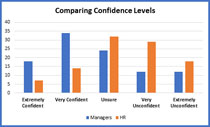Has Your Strategic Plan Fallen Down the Rabbit Hole?
 An executive coaching client suggested that “everything in her company is in disarray and nothing is getting accomplished.” As I began questioning her, it was easy to understand why. Current projects for this organization include:
An executive coaching client suggested that “everything in her company is in disarray and nothing is getting accomplished.” As I began questioning her, it was easy to understand why. Current projects for this organization include:
- Restructuring a large department while finding a new leader for it
- Opening two new branches in different towns.
- Acquiring another company
- A major remodeling project at headquarters
- Preparing for a major bi-annual meeting to be held in four months
- Putting together a succession plan in anticipation of the CEO’s retirement in a few years
Not only are there several major projects in the works, the CEO often loses track of what he has told his team, who is to do what, and how much progress has been accomplished on each project. In fact, on one of the new branch openings, three people had three different opening dates as their goal.
CEO, Change Management; Business,, Strategic Planning,
Read more: Has Your Strategic Plan Fallen Down the Rabbit Hole?
 Do your team’s behaviors emulate the famous musketeer slogan? Can you really have such a utopian culture; or is this idea just as fictional as the musketeer story? If your company is in trouble, is the idea of creating such a team going to distract from more urgent needs? If teambuilding is the only focus – yes. We all know that when teams begin experiencing disruptive behaviors, it is the manifestation of a deeper issue.
Do your team’s behaviors emulate the famous musketeer slogan? Can you really have such a utopian culture; or is this idea just as fictional as the musketeer story? If your company is in trouble, is the idea of creating such a team going to distract from more urgent needs? If teambuilding is the only focus – yes. We all know that when teams begin experiencing disruptive behaviors, it is the manifestation of a deeper issue. Change doesn’t come easily…or cheaply. Here’s a scenario: The Board or Executive Team, meet and hammer out their strategic plan and go back to work at their desks and begin putting the building blocks in place to reach the goals they’ve set. A few months, or a year into the plan, they suddenly discover that not only is change expensive, but it’s costly in ways and areas the strategic plan, well had no plan for. Every type of change comes with a price tag.
Change doesn’t come easily…or cheaply. Here’s a scenario: The Board or Executive Team, meet and hammer out their strategic plan and go back to work at their desks and begin putting the building blocks in place to reach the goals they’ve set. A few months, or a year into the plan, they suddenly discover that not only is change expensive, but it’s costly in ways and areas the strategic plan, well had no plan for. Every type of change comes with a price tag. In his book, The Personal MBA: Master the Art of Business,
In his book, The Personal MBA: Master the Art of Business,  Last week, I wrote a blog about how
Last week, I wrote a blog about how  Many people will resist change to the nth degree. Others will not only embrace it, but cause it to happen just for the fun of it. Whatever your preference when it comes to change, change itself at least in the corporate world, is itself, changing.
Many people will resist change to the nth degree. Others will not only embrace it, but cause it to happen just for the fun of it. Whatever your preference when it comes to change, change itself at least in the corporate world, is itself, changing. As a “recovering” Human Resources professional, working in hotels no less, I’ve had my share of difficult conversations with both guests and employees. Conversations with employees ranged from body odor, to inappropriate dress, unprofessional behavior, rule infractions, personality conflicts, petty territorial disagreements, and you name it. While some workplace conversations can be difficult, avoiding them is not recommended. First, we’ll look at the consequences avoiding difficult conversations can bring and then look at the essential steps for handling them.
As a “recovering” Human Resources professional, working in hotels no less, I’ve had my share of difficult conversations with both guests and employees. Conversations with employees ranged from body odor, to inappropriate dress, unprofessional behavior, rule infractions, personality conflicts, petty territorial disagreements, and you name it. While some workplace conversations can be difficult, avoiding them is not recommended. First, we’ll look at the consequences avoiding difficult conversations can bring and then look at the essential steps for handling them.
 Blind spots can be found in every element of business.
Blind spots can be found in every element of business.